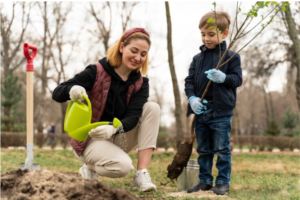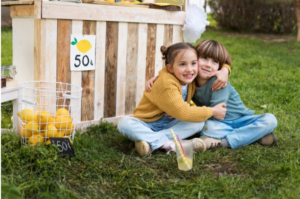Learn thorough methods for childproofing your house so that your children can grow up in a safe and supportive environment. Your handbook for protecting yourself from typical home threats.
Introduction
One of the most important things you can do to make sure your kids are safe and secure is to childproof your house. This procedure include evaluating potential risks in your house and putting mitigation strategies in place. A secure environment for your child to explore and develop is what childproofing is all about, from installing safety gadgets to bolting heavy furniture.
Why Childproofing Is So Important
There are a number of threats that young children could encounter in the household. Since accidents are one of the main causes of childhood injury and death, childproofing is crucial. Parental intervention can drastically lower the likelihood of accidents like poisoning, falls, and other injuries occurring in the home.

Professional childproofing services offer a practical and dependable answer for individuals who might not have the necessary time or experience. Safe Beginnings Childproofing is one of the services that offers thorough house assessments, safety product recommendations, and installation based on your needs.
Important Domains for Childproofing
Hallways and Stairs: To stop falls, install safety gates.
Windows: To prevent kids from falling out, install window guards.
Install safety latches on cabinets and drawers to limit access to potentially dangerous objects.
Appliances and furniture: Secure large, heavy items to avoid tipping.
Cover electrical outlets to protect yourself from electrical burns.
Selecting the Appropriate Safety Items
Choosing the right safety gear is essential. Window guards, safety latches, and outlet covers are examples of easily accessible options that can be customized to meet different types of home configurations. It’s critical to confirm that these goods are safe and long-lasting.
Water Security: Pools and buckets are examples of water hazards that need special attention. Drowning accidents can be avoided by erecting barriers around swimming pools and being watchful of water containers.
Drug Safety: All prescription and over-the-counter medications should be kept out of children’s reach in a secured, secure location. Watch out for backpacks or handbags that can carry prescription drugs.
Fire Safety: Install smoke detectors and fire escape ladders in your house.
First Aid: Consider enrolling in a first aid course with a specialization on newborns and children, and keep a fully equipped first aid kit on hand.
Entire Childproofing Techniques
Recognizing the Hazards
It’s critical to recognize the typical dangers that young children may encounter in their household. These include the possibility of poisoning, drowning, choking hazards, and objects falling or toppling over. Parents can better prepare their homes to be safe spaces by being aware of these threats.
Risks of Choking
Young children use their tongues to investigate the world because they are inherently interested. When it comes to little, readily ingested objects, this interest can become harmful. Make sure that little toys, batteries, coins, and other items are kept out of reach to reduce this risk. Check low-lying areas and floors frequently for potential choking hazards.
Hazards of Poisoning
If consumed by a youngster, household cleansers, medications, and even specific plants can be toxic. Keep all chemicals and pharmaceuticals in high, locked cabinets to avoid accidental poisoning. Keep medications out of children’s reach and exercise caution when handling purses or bags that might contain them.
Prevention of Drowning
Even in extremely small volumes of water, drowning can happen. When a child is in the bath, watch over them at all times and make sure that pails, buckets, and other small containers are emptied right away. It is essential to install a fence with a self-closing, self-latching gate if you have a swimming pool.
Keeping Accidents from Falling and Tipping
To stop furniture from toppling over, fasten bookcases and TV stands to the wall. For furniture with sharp edges, use corner guards. Make sure that any windows have locks or guards installed to stop falls.
Electrical Security: To prevent trips and falls, keep electrical cables out of reach and securely fastened. Make sure safety plugs are installed in all outlets, particularly those that are reachable by children. Install and periodically test smoke detectors in strategic areas of your house. Make sure your family has a fire escape plan and keep a fire extinguisher handy. Teach older kids the fundamentals of responding to emergencies.
Getting Expert Assistance
Although many parents choose to DIY childproof their homes, hiring professional childproofers is becoming more and more popular. These professionals may offer a thorough safety assessment of your house along with specially designed fixes. They can also install certain safety equipment that parents would find challenging to install on their own.

Monitoring the Development of Your Child
Your demands for childproofing will change as your children grow and acquire new talents. Review your house frequently, and change your safety precautions as needed. For instance, it becomes more crucial to secure windows and remove climbable things from close to obstacles as kids get older and can climb.
Crucial Methods for Childproofing
Safety in the Kitchen
One popular place to find possible hazards is the kitchen. It’s critical to:
- Place all chemicals, cleaning supplies, and possibly dangerous items in high cabinets secured with safety locks.
- Install knob covers to keep the stove from being accidentally switched on and stove guards to avoid burns.
- Knives and scissors should be kept in locked drawers.
- Make sure all appliances are locked or out of reach, especially heavier ones like toasters and microwaves.
Safety in the Bathroom
Burns, poisoning, and drowning are possible hazards in the restroom. To lessen these:
- Never, not even for a little minute, leave a youngster unsupervised in a bathtub.
- Install toilet locks to reduce the risk of drowning.
- Keep all cleaning supplies, cosmetics, and prescription drugs in secured cabinets.
- To avoid scalds, make sure the bath water temperature is not higher than 120 degrees Fahrenheit by adjusting your water heater.
Safety in the Bedroom
The bedroom of a youngster ought to be a secure sanctuary. Make sure of this by:
- Utilizing a crib with slats spaced no more than 2 3/8 inches apart and compliant with current safety regulations.
- Reducing the danger of suffocation in the crib by avoiding soft bedding and pillows.
- Fixing furniture to the wall to stop it from toppling over.
- putting toys and other items out of reach that could choke someone.
Safety in the Living Room
The living room ought to be childproofed as it’s frequently the main area where families congregate.
- Securing bulky furniture and TVs to the wall.
- Applying furniture edge and corner protectors.
- Keeping little items out of reach, like the batteries for remote controls.
- To avoid strangulation concerns, make sure window treatment cables are out of reach.
Generally Adherent Home Safety Advice
Around the house, keep in mind to:
- Put carbon monoxide and smoke detectors in every floor, especially those that are close to bedrooms.
- Keep a first aid kit close at hand.
- Store emergency numbers on the fridge or next to the phone, including poison control.
- As your child grows and explores new locations, make regular checks throughout the house for any hazards.
Education’s Function in Childproofing
It is essential that you and other caregivers become knowledgeable about potential risks and childproofing techniques. Participate in safety seminars, study current kid safety information, and keep abreast of product recalls and safety alerts. Childproofing is a continuous procedure that changes as your child grows instead of being a one-time job. To guarantee your child’s continuous protection, safety measures must be regularly reviewed and adjusted.
Conclusion
Finally, it should be noted that childproofing is a crucial component of parenting that calls for constant modification and attention. Your child can grow and play in a safe and nurturing environment if you thoroughly childproof every area of your home and keep up to date on safety precautions and potential hazards.
Maintaining your home’s childproofing demands constant attention to detail and modification as your child gets older. You can provide a safe space for your child to explore and develop by being aware of the risks, putting in place thorough safety precautions, and keeping up with the latest child safety best practices.
The process of childproofing is ongoing and changes as your child does and their surroundings do as well. Check your house frequently for possible dangers and update your safety precautions as necessary. Recall that the objective is to provide a secure atmosphere for learning and discovery.
We hope you found this information helpful in your journey to create a safer environment for your family. At GuardWell Safety, we understand that every home is unique, and so are your child-proofing needs. That’s why we offer a Free Child-Proofing Consultation tailored to your specific requirements. Let our experts help you identify potential hazards and provide personalized solutions to make your home a secure haven for your little ones. Book your free consultation today and take the first step towards peace of mind.






